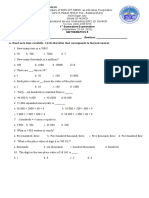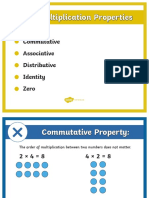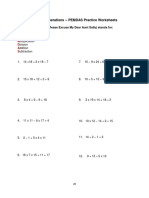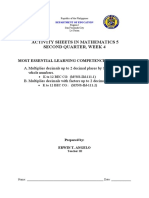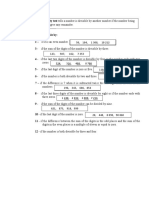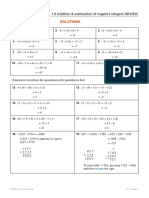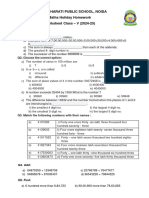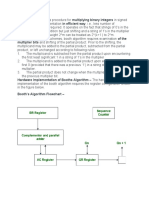Divisibility Rules
Divisibility Rules
Uploaded by
Sasha GrayCopyright:
Available Formats
Divisibility Rules
Divisibility Rules
Uploaded by
Sasha GrayCopyright
Available Formats
Share this document
Did you find this document useful?
Is this content inappropriate?
Copyright:
Available Formats
Divisibility Rules
Divisibility Rules
Uploaded by
Sasha GrayCopyright:
Available Formats
DIVISIBILITY RULES
f An integer, N, is a multiple of b if b can be evenly divided into N.
f If N is a multiple of b, then N is divisible by b.
f If N is a multiple of b, then b is a factor of N: N = b · a
Divisibility Rule for 1: 1 is a factor of every number, and every number is a factor of itself.
Divisibility Rule for 2: 2 is a factor of every even number.
Divisibility Rule for 3: If the sum of the individual digits of a number is a multiple of 3, then N is also
a multiple of 3
Divisibility Rule for 4: If the last two digits of a number are a multiple of 4, then the entire number is
a multiple of 4. (This rule is used for numbers that have at least three digits.)
Divisibility Rule for 5: 5 is a factor of every number that ends in either 5 or 0; in other words, the
ones digit is either 0 or 5.
Divisibility Rule for 6: If a number is a multiple of both 2 and 3, then it is also a multiple of 6.
Divisibility Rule for 7: If a number, N, is a multiple of 7, then another multiple of 7 can be found by
(i) subtracting the ones digit from N,
(ii) dividing the result by 10, and
(iii) subtracting, from that result, twice the original ones digit.
Divisibility Rule for 8: If the last three digits of a number is a multiple of 8, then the entire number is
a multiple of 8. (This rule is used for numbers that have at least four digits.)
Divisibility Rule for 9: If the sum of the individual digits is a multiple of 9, then the original number is
also a multiple of 9 (and 9 is a factor of that original number).
Divisibility Rule for 10: 10 is a factor of every number that ends in 0. 10 is a factor of every number
that has both 2 and 5 as factors.
Divisibility Rule for 11: In a number, N, if the difference of the sum of the even place digits and the
sum of the odd place digits is 0 or a multiple of 11, then N is a multiple of 11.
Exercises
1. Organize each set of digits into a whole number that is a multiple of 11.
a) 2, 4, 5, 6, 8, 9 b) 1, 2, 4, 5, 5, 8 c) 1, 3, 8, 9, 9
2. Based on the divisibility rules, above, determine which of the numbers 2 through 11 are factors of
the following.
a) 462 b) 8,712 c) 2,310
You might also like
- Chapter 2A Practice TestDocument2 pagesChapter 2A Practice TestMisterLemusNo ratings yet
- 2019 MTAP - Session 2 Grade 6Document28 pages2019 MTAP - Session 2 Grade 6agnes dumalaganNo ratings yet
- Ratios Rates and Proportions WorksheetDocument2 pagesRatios Rates and Proportions WorksheetUmu Yumumu100% (1)
- Summative Test in Math 3RD QuarterDocument3 pagesSummative Test in Math 3RD QuarterCriselda Bacatan VarcaNo ratings yet
- Third Periodical Exam Grade 2 ReviewerDocument9 pagesThird Periodical Exam Grade 2 ReviewerAbigail Bartolo100% (1)
- Variables, Algebraic Expressions, and Simple Equations - 1Document34 pagesVariables, Algebraic Expressions, and Simple Equations - 1Sreekumar VasudevanNo ratings yet
- Mathematics 5 Q2-Week 1Document28 pagesMathematics 5 Q2-Week 1Leonalyn De MesaNo ratings yet
- Ratio and ProportionDocument19 pagesRatio and ProportionMclin Jhon Marave MabalotNo ratings yet
- Mtap 8 Reviewer 19 Mtap 8 Reviewer 19Document1 pageMtap 8 Reviewer 19 Mtap 8 Reviewer 19Billy Mendoza100% (1)
- 1Q M6 Module 2 Multiplication of Fractions FinalDocument11 pages1Q M6 Module 2 Multiplication of Fractions Final7 - Carnelian Gian Yuri MoraNo ratings yet
- Percentage of Number Worksheet: Calculate The PercentagesDocument2 pagesPercentage of Number Worksheet: Calculate The PercentagesSatyam Kumar pandeyNo ratings yet
- Metrobank-Mtap-Deped Math Challenge 2016 Elimination Round: Answers With SolutionsDocument70 pagesMetrobank-Mtap-Deped Math Challenge 2016 Elimination Round: Answers With Solutionsjustine alinaNo ratings yet
- Numbers To Roman Numerals WorksheetDocument2 pagesNumbers To Roman Numerals WorksheetFloreid100% (1)
- Addition Test For Grade 1Document2 pagesAddition Test For Grade 1Arracab Rosel OninNo ratings yet
- Multiplying Radicals LessonDocument5 pagesMultiplying Radicals LessonthescamdogNo ratings yet
- MATH Q1 Lesson 8 Multiplying Numbers Up To Three Digits by Numbers... Marvietblanco (Autosaved)Document36 pagesMATH Q1 Lesson 8 Multiplying Numbers Up To Three Digits by Numbers... Marvietblanco (Autosaved)Jenielyn SadoNo ratings yet
- Mtap g6 NationalDocument3 pagesMtap g6 NationalDaisy Joy Sawitan Amplayo100% (1)
- Sum of The Interior Angles of A Triangle #2: ABC CAB CAB CAB ACB ACB CBA CBADocument2 pagesSum of The Interior Angles of A Triangle #2: ABC CAB CAB CAB ACB ACB CBA CBAGohan Dave AgmataNo ratings yet
- MATHDocument8 pagesMATHirene100% (1)
- EXAM - Math 5Document2 pagesEXAM - Math 5ROSELLE MEA EDERNo ratings yet
- Prime and Composite NumberDocument19 pagesPrime and Composite NumberHannahJean CabiloganNo ratings yet
- Numerates GRADE 5 EditDocument4 pagesNumerates GRADE 5 EditMary-Ann EscalaNo ratings yet
- Addition and Subtraction of FractionsDocument7 pagesAddition and Subtraction of FractionsMaria Diza Cebuano FebrioNo ratings yet
- Worksheet 7 - GCF and LCM Word ProblemDocument4 pagesWorksheet 7 - GCF and LCM Word Problemranulfo mayolNo ratings yet
- DiagnosticTest Math AbridgedVersionDocument5 pagesDiagnosticTest Math AbridgedVersionjerice9estavilloNo ratings yet
- Measurement Power Point Review 1h2al8a 120321201551 Phpapp01Document21 pagesMeasurement Power Point Review 1h2al8a 120321201551 Phpapp01Mary Grace YañezNo ratings yet
- MTAP Saturday Program in Mathematics Grade 1 Session 1Document2 pagesMTAP Saturday Program in Mathematics Grade 1 Session 1Luis SalengaNo ratings yet
- Math 4 Quarter 1 Week 7Document13 pagesMath 4 Quarter 1 Week 7mjherbietoNo ratings yet
- 5th Grade Math Lesson - Describing SolidsDocument5 pages5th Grade Math Lesson - Describing SolidsrenubagraNo ratings yet
- Active Community Contributors Institute (ACCI) : First Monthly AssessmentDocument3 pagesActive Community Contributors Institute (ACCI) : First Monthly AssessmentJohn Paul LumbresNo ratings yet
- Properties of Multiplication PostersDocument6 pagesProperties of Multiplication PostersrawheyaNo ratings yet
- Online Class Etiquette: Leave The Keyboard Alone. Dress Appropriately. Be Aware of Your SurroundingsDocument35 pagesOnline Class Etiquette: Leave The Keyboard Alone. Dress Appropriately. Be Aware of Your SurroundingsPrinceadonis GironNo ratings yet
- MTG Reviewer A PDFDocument18 pagesMTG Reviewer A PDFtae hyung100% (1)
- General Mathematics: Self - Learning ModuleDocument8 pagesGeneral Mathematics: Self - Learning ModuleKyla Renz de Leon100% (1)
- Squaring A Binomial and TrinomialDocument43 pagesSquaring A Binomial and TrinomialValerie BernilNo ratings yet
- Integer Pemdas PDFDocument2 pagesInteger Pemdas PDFCaryl Anne BalbasNo ratings yet
- Solve Multiplication ProblemsDocument12 pagesSolve Multiplication ProblemsZalina YaacobNo ratings yet
- Math-4th ExamDocument4 pagesMath-4th ExamROSALIE TARRAZONANo ratings yet
- Directions: Read and Understand Properly Each Item. Encircle The Letter of The Correct AnswerDocument6 pagesDirections: Read and Understand Properly Each Item. Encircle The Letter of The Correct AnswerLevie CatalbasNo ratings yet
- Diagnostic Test Grade 4Document24 pagesDiagnostic Test Grade 4THe Study HallNo ratings yet
- Chapter 6 - Ratio and ProportionDocument7 pagesChapter 6 - Ratio and ProportionnbhaNo ratings yet
- Third Periodical Test: Mathematics 4Document4 pagesThird Periodical Test: Mathematics 4Antonio Respicio Tagaca Jr.No ratings yet
- Place Value: The Value of The Place, or Position, of A Digit in A Number or SeriesDocument13 pagesPlace Value: The Value of The Place, or Position, of A Digit in A Number or SeriesEugene M. PidoNo ratings yet
- Prime and Composite NumbersDocument12 pagesPrime and Composite Numbersapi-352592738No ratings yet
- Activity Sheets in Mathematics 5 Second Quarter, Week 4: Most Essential Learning CompetenciesDocument14 pagesActivity Sheets in Mathematics 5 Second Quarter, Week 4: Most Essential Learning CompetenciesLloydNo ratings yet
- Dividing Fractions: Word Problems: Answer Each QuestionDocument1 pageDividing Fractions: Word Problems: Answer Each QuestionJanice ChingNo ratings yet
- Mtap ReviewerDocument9 pagesMtap Reviewerrodalyn ninofrancoNo ratings yet
- MTAP Elimination Grade 6Document2 pagesMTAP Elimination Grade 6Kier Wen LitaNo ratings yet
- Showing Properties of MultiplicationDocument10 pagesShowing Properties of MultiplicationDianne FranciscoNo ratings yet
- Squaring A Binomial Review PDFDocument3 pagesSquaring A Binomial Review PDFJezzel Ayessa Sagomez CastardoNo ratings yet
- Math 6 DLP 22 - Writing The Fraction Described by A Region Set and Number LineDocument12 pagesMath 6 DLP 22 - Writing The Fraction Described by A Region Set and Number LineSheena Marie B. AnclaNo ratings yet
- P E MD AS: PEMDAS Rules and Operations On Real NumbersDocument8 pagesP E MD AS: PEMDAS Rules and Operations On Real NumbersDryle YushirouNo ratings yet
- Fractions Lesson PowerpointDocument9 pagesFractions Lesson Powerpointapi-397919489No ratings yet
- Week 6 Quarter 2 WorksheetDocument10 pagesWeek 6 Quarter 2 WorksheetDiana Rose AlcantaraNo ratings yet
- Force, Motion, and EnergyDocument17 pagesForce, Motion, and EnergyItsNullLizardNo ratings yet
- Divisibility RuleDocument4 pagesDivisibility RuleKarla De Guzman HornillaNo ratings yet
- Math 5 3rd Quarter Examination 1Document4 pagesMath 5 3rd Quarter Examination 1Yamaha PasigNo ratings yet
- Measure Angles With A Protractor - Independent Practice WorksheetDocument2 pagesMeasure Angles With A Protractor - Independent Practice Worksheetapi-28443160550% (2)
- Math Test Basic Arithmetic and AlgebraDocument5 pagesMath Test Basic Arithmetic and AlgebraAndrea ElcanoNo ratings yet
- Lesson-1-Linear Inequalities in One VariableDocument28 pagesLesson-1-Linear Inequalities in One VariableAr Jay DavidNo ratings yet
- Elementary School ‘Grades 1 & 2: Math – Number – Ages 6-8’ eBookFrom EverandElementary School ‘Grades 1 & 2: Math – Number – Ages 6-8’ eBookNo ratings yet
- Solutions: 1.6 Addition & Subtraction of Negative Integers REVIEW Pull It All TogetherDocument1 pageSolutions: 1.6 Addition & Subtraction of Negative Integers REVIEW Pull It All TogetherMinh BachNo ratings yet
- Problems On AgesDocument10 pagesProblems On AgesLyrics World РусскийNo ratings yet
- 5.cut Off Adjusted Mean Baru - Lamp C1Document16 pages5.cut Off Adjusted Mean Baru - Lamp C1FAZZ CLASSICNo ratings yet
- Basic Mathematics SolutionDocument18 pagesBasic Mathematics SolutionAmay AnandNo ratings yet
- Test For Stat 25 - 04Document12 pagesTest For Stat 25 - 04sinh77No ratings yet
- (Class 5th) Decimals and AverageDocument8 pages(Class 5th) Decimals and AverageSnigdha GoelNo ratings yet
- Unit 3Document52 pagesUnit 3Roxane EsguerraNo ratings yet
- Ch-7 RD MathsDocument68 pagesCh-7 RD MathsThe VRAJ GAMESNo ratings yet
- Sequence & Series - All JEE 2023 PYQsDocument107 pagesSequence & Series - All JEE 2023 PYQss28376529No ratings yet
- CF - Maths: (UNIT 5: Fractions)Document1 pageCF - Maths: (UNIT 5: Fractions)AndyBrookeNo ratings yet
- Fractions PDFDocument44 pagesFractions PDFJohn Pridman100% (3)
- Amc8 V4Document168 pagesAmc8 V4Shuai ChenNo ratings yet
- Consolidated Test-1Document26 pagesConsolidated Test-1UnknownNo ratings yet
- Grade 5 Eureka EssentialsDocument93 pagesGrade 5 Eureka EssentialsBala GiridharNo ratings yet
- Chapter 2Document19 pagesChapter 2Roha CbcNo ratings yet
- Junior Secondary Mathematics175 - 126707893120100225Document266 pagesJunior Secondary Mathematics175 - 126707893120100225palkybdNo ratings yet
- TopicDocument4 pagesTopicChristian TabalanNo ratings yet
- Mtap 2Document40 pagesMtap 2chatNo ratings yet
- Maths Holiday Homework 2024-25Document3 pagesMaths Holiday Homework 2024-25sofiagoelNo ratings yet
- Unit Test Ii Maths STD 4Document7 pagesUnit Test Ii Maths STD 4sriramabclNo ratings yet
- BSTAT-Short Type Selected Question Answer Set-1Document22 pagesBSTAT-Short Type Selected Question Answer Set-1tihato8838No ratings yet
- 1's and 2's Complement Lecture 3Document20 pages1's and 2's Complement Lecture 3rashmi patil0% (1)
- Aptitude Test Unit 1Document24 pagesAptitude Test Unit 1Sangatamil Ias AcademyNo ratings yet
- NumberDocument9 pagesNumbershibasispanda.aryaNo ratings yet
- Class 9 Notes Real NumbersDocument3 pagesClass 9 Notes Real Numberskmokshita4No ratings yet
- Binder 1Document122 pagesBinder 1prabhatpandey9420No ratings yet
- Math 3u - Estimating DifferenceDocument16 pagesMath 3u - Estimating DifferenceZL TenorioNo ratings yet
- ABM11 Business Math Q1 W1 MODULE1Document13 pagesABM11 Business Math Q1 W1 MODULE1Ian BoneoNo ratings yet
- Multiplier Bits and Shifting of The Partial Product. Prior To The Shifting, TheDocument4 pagesMultiplier Bits and Shifting of The Partial Product. Prior To The Shifting, TheMAHESH SNo ratings yet



















